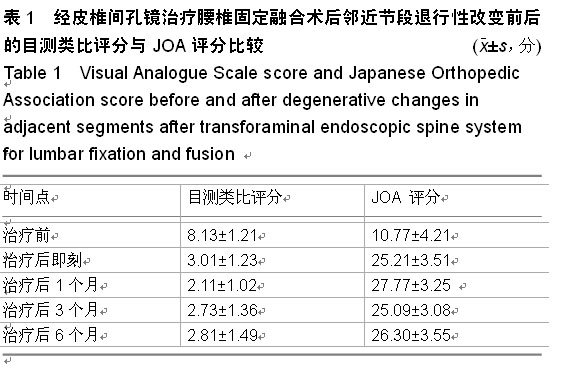| [1] Ekman P,Moiler H,Shalabi A,et al.A prospective randomized study Oil the longterm effect of lumbar fusion on adjacent disc degeneration.Eur Spine J.2009;18(8):1175-1186.
[2] Lu K,Liliang PC,Wang HK,et al.Reduction in adjacent-segment degeneration after multilevel posterior lumbar interbody fusion with proximal DIAM implantation.J Neurosurg Spine.2015:1-7.[Epub ahead of print]
[3] Nakashima H, Kawakami N,Tsuji T,et al.Adjacent Segment Disease after Posterior Lumbar Interbody Fusion: Based on Cases with a Minimum of 10 years of Follow Follow-Up.Spine (Phila Pa 1976). 2015.[Epub ahead of print]
[4] Lee JC,Lee SH,Peters C,et al.Adjacent Segment Pathology Requiring Reoperation After Anterior Cervical Arthrodesis: The Influence of Smoking, Sex, and Number of Operated Levels.Spine (Phila Pa 1976).2015;40(10):E571-E577.
[5] Ou CY,Lee TC,Lee TH,et al.Impact of body mass index on adjacent segment disease after lumbar fusion for degenerative spine disease.Neurosurgery.2015;76(4):396-401.
[6] Okuda S,Oda T,Miyauchi A,et al.Lamina horizontalization and facet tropism as the risk factors for adjacent segment degeneration after PLIF.Spine (Phila Pa 1976).2008;33 (25): 2754-2758.
[7] Zencica P,Chaloupka R,Hladíková J,et al.Adjacent segment degeneration after lumbosacral fusion in spondylolisthesis: a retrospective radiological and clinical analysis.Acta Chir Orthop Traumatol Cech.2010;77(2):124-130.
[8] Okuda S,Oda T,Yamasaki R,et al.Repeated adjacent-segment degeneration after posterior lumbar interbody fusion.J Neurosurg Spine.2014;20(5):538-541.
[9] Ha KY,Son JM,Im JH,et al.Risk factors for adjacent segment degeneration after surgical correction of degenerative lumbar scoliosis.Indian J Orthop.2013;47(4):346-351.
[10] Imagama S,Kawakami N,Kanemura T,et al.Radiographic Adjacent Segment Degeneration at Five Years After L4/5 Posterior Lumbar Interbody Fusion With Pedicle Screw Instrumentation: Evaluation by Computed Tomography and Annual Screening With Magnetic Resonance Imaging.J Spinal Disord Tech.2013.[Epub ahead of print]
[11] Chen BL,Wei FX,Ueyama K,et al.Adjacent segment degeneration after single-segment PLIF: the risk factor for degeneration and its impact on clinical outcomes.Eur Spine J. 2011;20(11):1946-1950.
[12] 高国勇,陈廖斌,镇万新,等.经皮椎间孔镜微创技术治疗腰椎间盘突出症[J].中华显微外科杂志,2012,35(5):423-425.
[13] 赵伟,李长青,周跃,等.经皮椎间孔镜下TESSYS技术治疗腰椎间盘突出症[J].中国矫形外科杂志,2012,20(13):1191-1195.
[14] Hilibrand AS,Robbins M.Adjacent segment degeneration and adjacent segment disease:the consequences ofspinal fusion.Spine (Phila Pa 1976).2004;4(6Suppl):190-194.
[15] Weinhoffer SL,Guyer RD,Herbert M,et al.Intradiscal pressure Measurements above an instrumented fusion:a cadaveric study.Spine (Phila Pa 1976).1995;20(5):526-531.
[16] Hoogendoorn RJ,Helder MN,Wuisman PI,et al.Adjacent segment degeneration observations in a goat spinal fusion study.Spine(Phila Pa1976).2008;33(12):1337-1343.
[17] 周跃,李长青,王健,等.椎间孔镜YESS与TESSYS技术治疗腰椎间盘突出症[J].中华骨科杂志,2010,30(3):225-231.
[18] 张德辉,朱显科,左新成,等.经皮椎间孔镜治疗高龄腰椎椎间盘突出并神经根管狭窄的短期疗效[J].脊柱外科杂志,2015,13(1): 24-27.
[19] 白一冰,李嵩鹏,王力文,等.改良TESSYS技术治疗腰椎神经根管狭窄症[J].颈腰痛杂志,2015,36(1):16-19.
[20] 杨林,鹿洪辉.椎间孔镜技术与开放手术在治疗伴有骨质疏松的腰椎管狭窄症的疗效及安全性比较[J].中华老年多器官疾病杂志,2014,13(7):507-511.
[21] 金晓锋,白一冰.椎间孔镜技术治疗脱出游离型腰椎间盘突出症疗效分析[J].中国疼痛医学杂志,2014,20(6):441-442.
[22] 薛祥云,左小华,赵红霞,等.TESSYS椎间孔镜技术在腰椎间盘突出症中治疗技巧探讨[J].中国疼痛医学杂志,2014,20(6): 401-404.
[23] 宋科冉,李振宙,侯树勋,等.经皮椎间孔入路全内镜技术治疗腰椎间盘突出症[J].中国骨与关节杂志,2014,13(8):626-629.
[24] 刘昊楠,林欣,潘海涛,等.应 用椎间孔镜TESSYS 技术治疗腰椎间盘突出症[J].首都医科大学学报,2012,33(6):827-832.
[25] 曾月东,何慕舜,杨湘江,等.椎间孔镜下髓核摘除术治疗椎间盘退变性腰腿痛[J].颈腰痛杂志,2012,33(4):281-284.
[26] 滑国田,袁志刚,赖茂文.经皮椎间孔镜TESSYS技术治疗腰椎间盘突出症18例的近期疗效[J].医学信息,2014,28(10):87-88.
[27] 徐宝山,马信龙,夏群,等.椎间孔镜TESSYS技术治疗腰椎间盘突出症效果分析[J].天津医药,2014,46(5):470-472.
[28] 史凡祺,张为,冯硕,等.经皮椎间孔镜TESSYS技术治疗中央型腰椎间盘突出症[J].临床和实验医学杂志,2014,13(8):621-625.
[29] 吴小程,周跃,李长青.经皮穿刺椎间孔镜与显微内窥镜治疗腰椎间盘突出症的前瞻性随机对照研究[J].第三军医大学学报, 2009,31(9):843-846.
[30] Postacchini F,Postacchini R.Operative management of lumbar discherniation: the evolution of knowledge and surgical techniques in the last century.Acta Neurochir Suppl. 2011;108:17-21. |


.jpg)